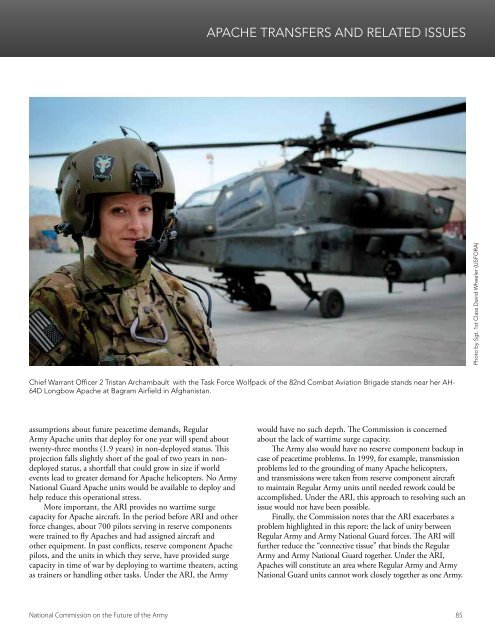THE FUTURE OF THE ARMY
Futurearmy
Futurearmy
You also want an ePaper? Increase the reach of your titles
YUMPU automatically turns print PDFs into web optimized ePapers that Google loves.
APACHE TRANSFERS AND RELATED ISSUES<br />
Photo by Sgt. 1st Class David Wheeler (USFORA)<br />
Chief Warrant Officer 2 Tristan Archambault with the Task Force Wolfpack of the 82nd Combat Aviation Brigade stands near her AH-<br />
64D Longbow Apache at Bagram Airfield in Afghanistan.<br />
assumptions about future peacetime demands, Regular<br />
Army Apache units that deploy for one year will spend about<br />
twenty-three months (1.9 years) in non-deployed status. This<br />
projection falls slightly short of the goal of two years in nondeployed<br />
status, a shortfall that could grow in size if world<br />
events lead to greater demand for Apache helicopters. No Army<br />
National Guard Apache units would be available to deploy and<br />
help reduce this operational stress.<br />
More important, the ARI provides no wartime surge<br />
capacity for Apache aircraft. In the period before ARI and other<br />
force changes, about 700 pilots serving in reserve components<br />
were trained to fly Apaches and had assigned aircraft and<br />
other equipment. In past conflicts, reserve component Apache<br />
pilots, and the units in which they serve, have provided surge<br />
capacity in time of war by deploying to wartime theaters, acting<br />
as trainers or handling other tasks. Under the ARI, the Army<br />
would have no such depth. The Commission is concerned<br />
about the lack of wartime surge capacity.<br />
The Army also would have no reserve component backup in<br />
case of peacetime problems. In 1999, for example, transmission<br />
problems led to the grounding of many Apache helicopters,<br />
and transmissions were taken from reserve component aircraft<br />
to maintain Regular Army units until needed rework could be<br />
accomplished. Under the ARI, this approach to resolving such an<br />
issue would not have been possible.<br />
Finally, the Commission notes that the ARI exacerbates a<br />
problem highlighted in this report: the lack of unity between<br />
Regular Army and Army National Guard forces. The ARI will<br />
further reduce the “connective tissue” that binds the Regular<br />
Army and Army National Guard together. Under the ARI,<br />
Apaches will constitute an area where Regular Army and Army<br />
National Guard units cannot work closely together as one Army.<br />
National Commission on the Future of the Army 85


